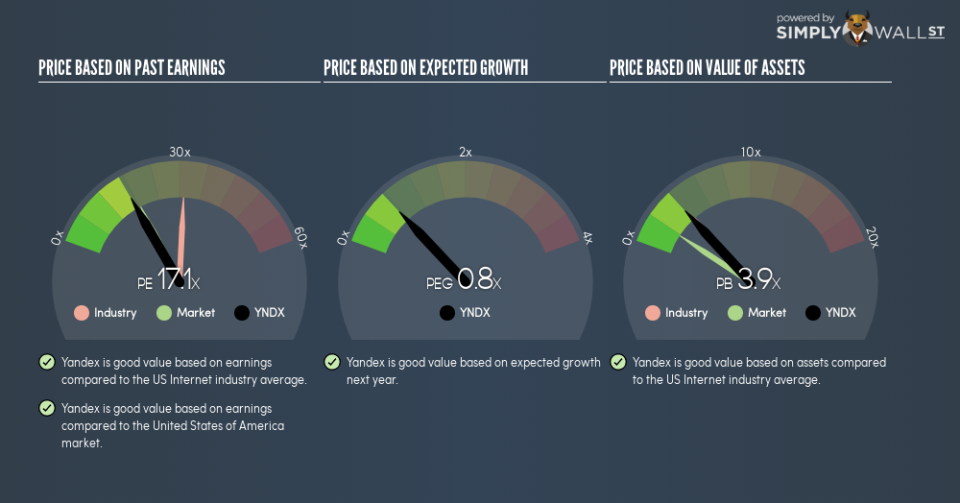Does Yandex NV’s (NASDAQ:YNDX) PE Ratio Warrant A Buy?

I am writing today to help inform people who are new to the stock market and want to start learning about core concepts of fundamental analysis on practical examples from today’s market.
Yandex NV (NASDAQ:YNDX) trades with a trailing P/E of 17.1x, which is lower than the industry average of 37.6x. While this makes YNDX appear like a great stock to buy, you might change your mind after I explain the assumptions behind the P/E ratio. In this article, I will deconstruct the P/E ratio and highlight what you need to be careful of when using the P/E ratio.
Check out our latest analysis for Yandex
What you need to know about the P/E ratio
P/E is often used for relative valuation since earnings power is a chief driver of investment value. It compares a stock’s price per share to the stock’s earnings per share. A more intuitive way of understanding the P/E ratio is to think of it as how much investors are paying for each dollar of the company’s earnings.
P/E Calculation for YNDX
Price-Earnings Ratio = Price per share ÷ Earnings per share
YNDX Price-Earnings Ratio = RUB2144.18 ÷ RUB125.065 = 17.1x
The P/E ratio itself doesn’t tell you a lot; however, it becomes very insightful when you compare it with other similar companies. Our goal is to compare the stock’s P/E ratio to the average of companies that have similar attributes to YNDX, such as company lifetime and products sold. A common peer group is companies that exist in the same industry, which is what I use. Since YNDX’s P/E of 17.1 is lower than its industry peers (37.6), it means that investors are paying less for each dollar of YNDX’s earnings. This multiple is a median of profitable companies of 24 Internet companies in US including CathayOnline, InsPro Technologies and Advanced Technologies Group. One could put it like this: the market is pricing YNDX as if it is a weaker company than the average company in its industry.
A few caveats
However, it is important to note that this conclusion is based on two key assumptions. Firstly, our peer group contains companies that are similar to YNDX. If this isn’t the case, the difference in P/E could be due to other factors. For example, if you compared lower risk firms with YNDX, then investors would naturally value it at a lower price since it is a riskier investment. The second assumption that must hold true is that the stocks we are comparing YNDX to are fairly valued by the market. If this does not hold, there is a possibility that YNDX’s P/E is lower because our peer group is overvalued by the market.
What this means for you:
If your personal research into the stock confirms what the P/E ratio is telling you, it might be a good time to add more of YNDX to your portfolio. But keep in mind that the usefulness of relative valuation depends on whether you are comfortable with making the assumptions I mentioned above. Remember that basing your investment decision off one metric alone is certainly not sufficient. There are many things I have not taken into account in this article and the PE ratio is very one-dimensional. If you have not done so already, I highly recommend you to complete your research by taking a look at the following:
Future Outlook: What are well-informed industry analysts predicting for YNDX’s future growth? Take a look at our free research report of analyst consensus for YNDX’s outlook.
Past Track Record: Has YNDX been consistently performing well irrespective of the ups and downs in the market? Go into more detail in the past performance analysis and take a look at the free visual representations of YNDX’s historicals for more clarity.
Other High-Performing Stocks: Are there other stocks that provide better prospects with proven track records? Explore our free list of these great stocks here.
To help readers see past the short term volatility of the financial market, we aim to bring you a long-term focused research analysis purely driven by fundamental data. Note that our analysis does not factor in the latest price-sensitive company announcements.
The author is an independent contributor and at the time of publication had no position in the stocks mentioned. For errors that warrant correction please contact the editor at editorial-team@simplywallst.com.

 Yahoo Finance
Yahoo Finance 
